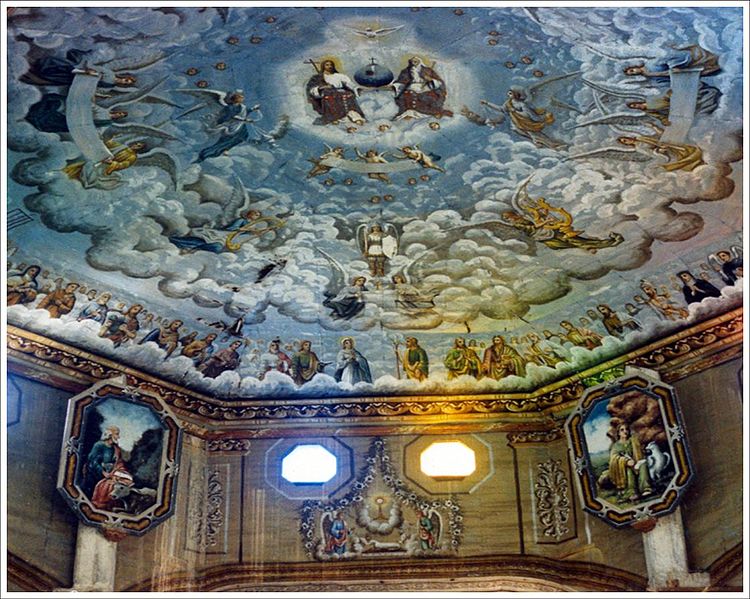|
CALENDAR of the SAINTS
Anno Dómini 26 February 2012

Ceiling Paintings of Balilihan Roman Catholic church
"....and, lo, a great multitude, which no man could number, of all nations, and kindreds, and people, and tongues, stood before the throne, and before the Lamb, clothed with white robes, and palms in their hands; And cried with a loud voice, saying, Salvation to our God which sitteth upon the throne, and unto the Lamb. ~ ~ Apocalypse
Α ☧ Ω
Bishop Saint Agricola of Nevers, France
Bishop of Nevers, France from A.D. 570 to 594.
Α ☧ Ω

Saint Alexander of Alexandria, Egypt
Known as a pious youth. Bishop of Alexandria, Egypt in 313. Worked against Arianism, and excommunicated Arius when he preached in the area around Alexandria. Key figure in the Council of Nicaea in 325. Patriarch of Alexandria. Doctor of the Church.
Α ☧ Ω
Bishop Saint Andrew of Florence, Italy
Named in the Book of Saints, by the Monks of Ramsgate
Α ☧ Ω
Saint Cyriacus Maria Sancha y Hervás
Bishop Saint Dionysius of Augsburg, Germany, Martyr
First bishop of Augsburg, Germany. Both baptized into the faith and later consecrated as bishop by Saint Narcissus. Martyred A.D. 303, in the persecutions of Diocletian.
Α ☧ Ω
Bishop Saint Faustinian of Bologna, Italy
Fourth century bishop of Bologna, Italy. A great administrator, he re-organized the diocese, and fought Arianism.
Α ☧ Ω
Saint Felix
Α ☧ Ω
Bishop Saint Fortunatus of Bologna. Italy
Second bishop of Bologna. Italy. who suffered during the persecution of co-Emperor Diocletian but survived. He was an ardent foe of the Arian heresy.
Α ☧ Ω
Saint Inger
Saint Irene
Raised a pagan. At about 14 years of age, she witnessed a mob abusing Saint Porphyrius for his faith. The violence sickened her, and she came to his rescue, causing enough trouble that the pagans left him alone. He recovered and converted her to Christianity.
Α ☧ Ω
Blessed Isabella of France
Daughter of Blanche of Castile. Only sister of Saint Louis IX. Declined a marriage offer from the German emperor in order to found a Poor Clare convent at Longchamps near Paris, France where she lived as a nun, though without taking vows.
Α ☧ Ω
Saint Leo of Saint-Bertin
Α ☧ Ω
Saint Mechthild of Sponheim
Α ☧ Ω
Saint Nestor of Magydos
Saint Papias and Companions, Martyrs All
One of four shepherds, with Conon, Claudian, and Diodorus, executed in Pamphylia, Asia Minor, during the persecutions of Emperor Trajanus Decius.
Α ☧ Ω

Sister Saint Paula of Saint Joseph of Calasanz
Daughter of Ramon and Vicenta Fornes Montal. Raised in a large and pious family in a small seaside village. Her father died when Paula was 10 years old. She worked as a seamstress and lace-maker, and helped raise her siblings, then helped in her parish to care for other children.
At age thirty, still single and devoting herself privately to God, she and her friend Inez Busquets opened a school in Gerona to provide a good education mixed with spiritual guidance. The school was such a success that she was able to found a college A.D. May 1842, and another school A.D. 1846. To staff and manage the schools, she founded the Daughters of Mary ( Pious School Sisters ) on 2 February 1847, and took the name Paula of Saint Joseph of Calasanz. Saint Paula served as the leader of the congregation, receiving approval from Pope Blessed Pius IX in 1860. The schools have now functioning on four continents.
Α ☧ Ω
Saint Piedad Ortiz Real
Α ☧ Ω
Bishop Saint Porphyrius of Gaza
Born to wealth. Hermit in the desert of Skete, Egypt. Hermit in Palestine on the bank of the Jordan River. Reluctant bishop of Gaza, he took to this assignment with great zeal and devotion. He converted almost all of his diocese, and nearly eliminated paganism in it.
Α ☧ Ω
Blessed Robert Drury, Martyr
Studied at the English College, Rheims, France A.D. 1588, and the English College, Valladolid, Spain A.D. 1590. Ordained at Valladolid A.D. 1593. Returned to England A.D. 1593 to minister to covert Catholics around London, England. One of the signers of the loyal address A.D. 31 January 1603 which acknowledged the queen as lawful sovereign on earth, but maintained their loyalty in religious matters to the Pope. When James I came to the throne, the king required them to sign a new oath which acknowledged his authority over spiritual matters. Robert refused, and was arrested A.D. 1606 for the crime of being a priest. He was offered his freedom if he would sign the oath; he declined. For his devotion to the Vicar of Christ on Earth Blessed Robert Drury was hanged, drawn, and quartered A.D. 26 February 1607 at Tyburn, London England.
Α ☧ Ω
Saint Sebastian of Posjekhonje
Α ☧ Ω
Saint Ulric of Obermarchtal
Α ☧ Ω
Saint Victor the Hermit
Born to nobility and raised in a pious, well-educated family. Priest. Hermit at Arcis-sur-Aube in the Champagne region of France. His life and wisdom caused many pagans to convert to Catholicism. Saint Bernard of Clairvaux composed an Office and several hymns about him.
Α ☧ Ω


|